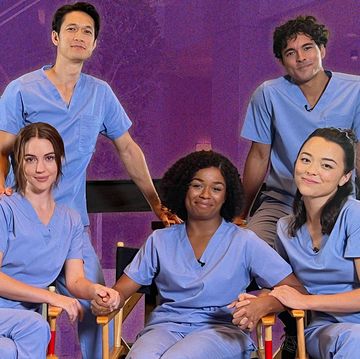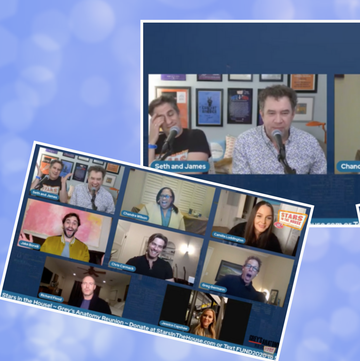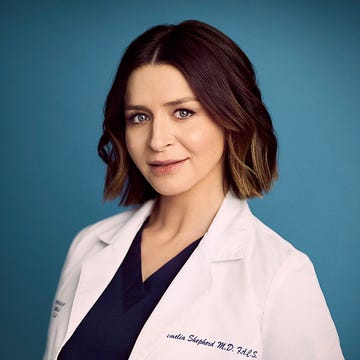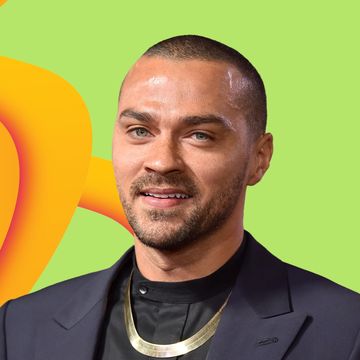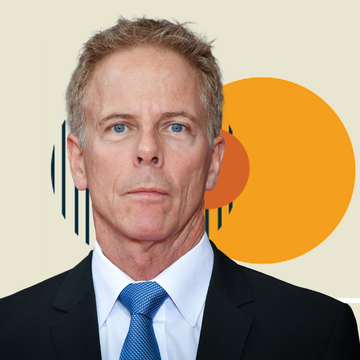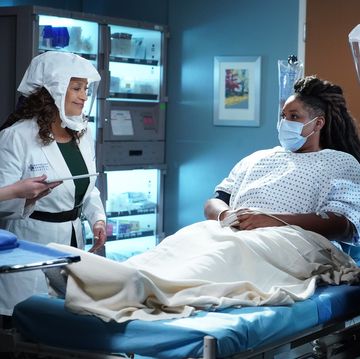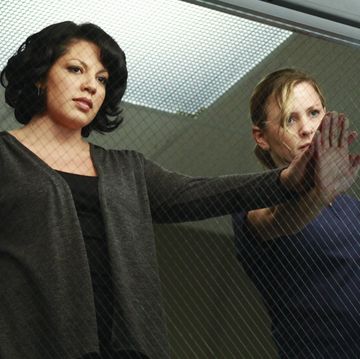It was the introduction heard ’round the world: “You must be the woman who’s been screwing my husband.” And so, Dr. Addison Montgomery burst onto Grey’s Anatomy at the end of the first season — and thus into our lives forever. The same could be said for Kate Walsh, who, before donning Addison’s scrubs, was a young actor with a few TV roles under her belt, including The Drew Carey Show, and smaller roles in films like Under the Tuscan Sun and The Family Man. And though Dr. Montgomery’s arc as a brilliant neonatal surgeon and the disgruntled ex-wife of Derek Shepherd was only meant to be a few episodes long, Walsh won over the hearts of viewers and creators alike.
“When you have such a great script, such great writing, you just have to show up and try to be open and let it play through you,” says Walsh over Zoom from her new adopted home of Western Australia. “That’s what Shonda has created, this great space for people to show up and be the conduit for her [ideas].”
And it was the writing again that brought Addie — pencil skirt, stilettos, fiery hair, determined eyes, and all — back into our lives on September 30 as she half-jokingly says to the residents, echoing that first line all those years ago, “You must be the group that’s been screwing up the program.”
In the two seasons Walsh played Addison as a Grey’s Anatomy season regular, Addison became such a fan favorite that Shonda Rhimes gave her the show’s first spinoff, Private Practice, in 2007. It ran for six seasons, with loads of fun and/or dramatic Grey’s Anatomy crossover episodes, but the last time we actually saw Addison, she was still at Seaside Wellness Center in Los Angeles, having come out on the other side of some pretty rough professional and romantic ordeals. She adopted the child she’d always wanted, and in the Private Practice series finale she married her coworker, Jake (Benjamin Bratt).
Grey’s Anatomy showrunner Krista Vernoff and Walsh had been talking since 2019 about bringing Addison back, but at the time Walsh had a scheduling conflict due to her role as The Handler in Netflix’s The Umbrella Academy. But Walsh says that she wanted to keep talking. So, Vernoff circled back after the lockdowns and asked if Walsh was available. In Australia at the time but knowing she was headed back to the Northern Hemisphere for her appearance in Emily in Paris, Walsh said, “Let’s do it.”
“She told me what she was thinking story-wise,” says Walsh, “but, per Grey’s, I didn’t get the script until the Zoom table read. And I was super-delighted to see that Jamie Denbo had written it, one of my oldest friends. It was just such classic, vintage Grey’s for me in that opening episode. And then in the second episode, in a different way, it was too, but a much more contained story line with Addison and Amelia reconnecting. It’s the best of Grey’s, though — that humor and pathos and life and death.”
Shondaland caught up with Walsh to talk about being back on that set and the emotions that came with it, what she did and didn’t miss, and whether we’ll be seeing more of Dr. Montgomery.
VALENTINA VALENTINI: What was something that you thought that you missed, but you actually really didn’t, when you came back to the set?
KATE WALSH: That is a really interesting question. I can literally say I’ve never been asked that before [laughs].
VV: Oh, good. I’m doing a good job then!
KW: Hmm. I don’t know. What did I miss? I mean, I don’t miss 16-hour days. That’s never been something I’ve enjoyed. But I wouldn’t say, “Oh, I thought I longed for that.” Okay, here, I’ll say it: I was excited about doing surgery. And then I forgot how tedious surgery scenes are. But that’s not even fair. I’m not a Pollyanna. The glass half full version of that — and, if I didn’t look at life that way, it just wouldn’t be good — is that I got to work with the illustrious nurse Linda Klein, who, from my day one on Grey’s all those years ago, taught me so much and made me look like I was actually a world-class, neonatal, double board-certified, badass surgeon, even with my hands shaking as I made my first fake incision in surgery.
VV: Who were some of the other people whom you were excited to see again?
KW: Part of the biggest joy of coming back was seeing all the crew, some of whom have been there since day one. They’re just delightful, beyond hard-working humans that all lean in to make the show incredible.
VV: What have you learned as an actor and as a woman that you took with you on set again that maybe wasn’t something you had back in the day?
KW: One of the things I did not anticipate was how I sort of regressed. It’s like when you go home for Thanksgiving or something, when you’re like, “Oh, wait. How did I become 15 again?” And I’m in my old room, behaving like I did with my parents as a teenager. In that sense, I regressed a little. It’s hard to explain, but you sort of fall back into this strange place, like a fever dream of going back to who you were then. And it forces you as a human, as an actor, to assess, and you can’t help but think of all the things that have transpired over the last 18 years. It is like going back to this weird, dusty attic and looking at a box of photos of your life, and it’s intense. It was a very intense experience.
VV: Sounds like it got pretty emotional.
KW: Totally. Ellen and I, I think we’re both very emotional. Chandra didn’t have time to be emotional because she was directing [laughs]. But it was very emotional for me. And also, my favorite, Laura Petticord, was our base camp assistant director, and she’s just incredible. I mean, these things sound corny, but that’s the first person I used to see every morning, getting out of my car at 4:30 a.m. when it’s still dark out. It’s the first person who greeted me and then knocked on my trailer door to tell me to go to hair and makeup. A lot of those moments felt like The Truman Show; like I went to sleep and woke up back in time, but in these great, very meaningful ways. And Norman Leavitt, who did my makeup back in the day, he is retired now, but he came back to do my makeup. That is such a beautiful thing — these rituals matter, and these are the things that make me emotional but also ground me.
VV: Did you ask specifically for him to come back?
KW: Yeah. Krista Vernoff and I were talking, and I think I asked, “Hey, can I get Normy to do this?” She said he was kind of retired but comes back sometimes. He came back to do Patrick Dempsey’s makeup. So, I asked him, and that was special for me. Everything becomes very symbolic.
VV: In line with that symbolism, did it feel like an adult Addison coming in compared to a baby Addison before? Or did it just feel like an extension of who she always was?
KW: That’s what I mean by regression. Like on Private Practice, I was number one on the call sheet, and on Grey’s I was number 10. And that was just a weird metaphor for being one of the kids again. It’s like falling through a wormhole in time, and you’re like, “Oh, I’m back.” And it’s not about being number one or number 10 — it’s just that cocky Addison again; she’s back in this teaching hospital, so she’s a kid again. Private Practice was so different; it was so adult. Even though we were all fallible and just as weird and gooey and crunchy and strange as all the other great characters in Shondaland. But it was Grey’s — a teaching hospital with all that strange intimacy and competitive arrogance, even though it’s tongue-in-cheek.
VV: Talk about taking you back — they literally gave you a line that perfectly echoes your first line from 2005.
KW: I know! Exactly. That was a lot of pressure because I wanted it to come out well. I didn’t want to hit it too hard. It’s an homage to the fans and her first entrance, but it’s a strange thing to play as an actor.
VV: There are two scenes in episode three — the scene in the elevator with Meredith, and meeting Derek’s kids — that were emotional to watch as a fan. What was it like filming them?
KW: It was very intense. There were so many layers, and those were such emotional scenes in the episode, I would imagine for fans too. Especially because they built up the Meredith and Addison thing, like, are they going to fight? Is it going to happen in that elevator? Is this going to be, “Hold my gold; I’m going to jail tonight,” or what? I thought it was such brilliant writing on Jamie’s part, and it was really important for me to get that [monologue in the elevator] verbatim, which is always challenging when emotions come into play. Like, when you have these heightened circumstances — this is a woman who didn’t go to her ex-husband’s funeral, who’s been away for years and just did an intense however many hours of surgery, who had some sort of connection and peacemaking with Meredith — it works with the narrative of their positions. Addison, the alpha, and now Meredith, who has taken over and has invited her in. And then the kids, with one of them who looks very much like Derek. You just have to be open to all the things that you’re processing as an actor and as the character. It was just beautiful to play it. I hope it worked.
VV: Well, I know I don’t speak for just myself when I say that we hope to see more of Dr. Addison Montgomery. I mean, is this the last time we see her?
KW: I don’t know. I don’t know. It remains to be seen.
VV: Do you feel like she’s left a legacy on Grey’s Anatomy? And what do you think that is, if so?
KW: Legacy is such a big word. [Pauses.] I don’t think I’m one to pontificate about a legacy. But I do know that Addison is an iconic character. And that’s Shonda. She created that character, and then I came in and interpreted it. And then the fans identified. She was a villain, and then you turn the villain over, and you see her tender underbelly. I remember, even back in that day, Shonda telling me that people are naming their children Addison, that it was in the top 10 baby names. But that’s the power of art, the power of storytelling. That’s what connects us, whether it’s great literature or painting or television or film or sculpture. People are moved. And then we’re connected. What Shonda has created is the legacy.
Valentina Valentini is a London-based entertainment, travel, and food writer and also a Senior Contributor for Shondaland. Elsewhere she has written for Vanity Fair, Vulture, Variety, Thrillist, Heated, and The Washington Post. Her personal essays can be read in the Los Angeles Times, Longreads, and her tangents and general complaints can be seen on Twitter at @ByValentinaV.
Get Shondaland directly in your inbox: SUBSCRIBE TODAY




